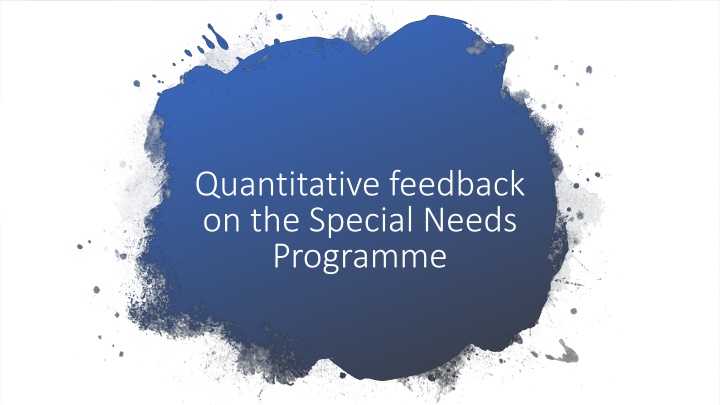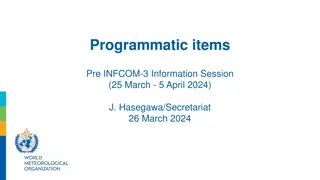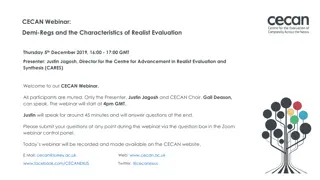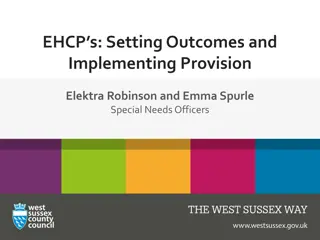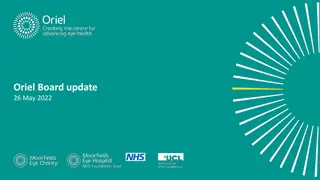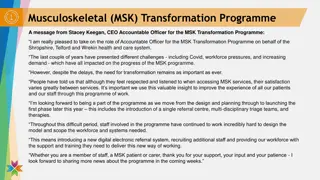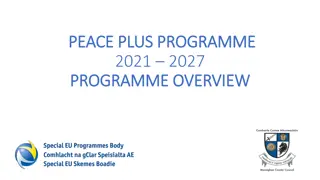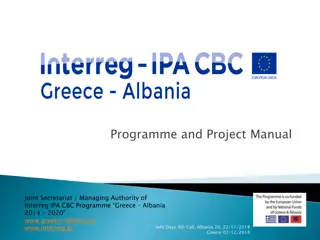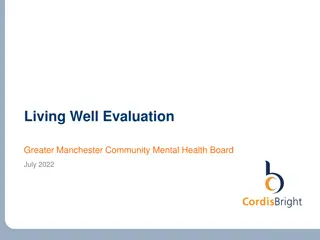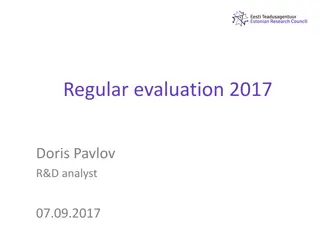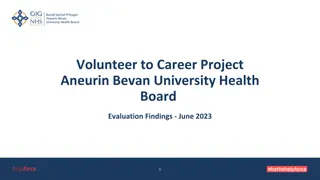Positive Outcomes of Special Needs Programme Evaluation
Quantitative feedback from a cluster randomized controlled trial on a Special Needs Programme involving 24 services and 277 parents revealed improvements in parenting practices, family adjustment, and parental satisfaction for participants enrolled in the programme. Comparisons between program participants and those on the waiting list showed significant positive changes in various outcomes. Follow-up data from 78 parents who completed the programme indicated significant improvements in several areas with large effect sizes. Notably, there were no significant changes in emotional problems or prosocial behaviors.
Download Presentation

Please find below an Image/Link to download the presentation.
The content on the website is provided AS IS for your information and personal use only. It may not be sold, licensed, or shared on other websites without obtaining consent from the author.If you encounter any issues during the download, it is possible that the publisher has removed the file from their server.
You are allowed to download the files provided on this website for personal or commercial use, subject to the condition that they are used lawfully. All files are the property of their respective owners.
The content on the website is provided AS IS for your information and personal use only. It may not be sold, licensed, or shared on other websites without obtaining consent from the author.
E N D
Presentation Transcript
Quantitative feedback on the Special Needs Programme
What did we do? Cluster randomized controlled trial including 24 services and 277 parents. Three timepoints; pre-, postintervention for both groups and 3-month follow-up for the intervention group. Self-report measures used: Parenting and Family Adjustment Scales Child Adjustment and Parent Efficacy Scale Developmental Disability Kansas Parenting Satisfaction Scale Parents Plus Goal Form Primary outcomes: Parenting Practices, Family Adjustment, Problem Behaviors, Emotional Problems, and Prosocial Behaviors. Secondary outcomes: Parental Satisfaction, Parental Self-efficacy, and Goal Attainment.
Assessed for eligibility (n=27) Excluded: Did not meet inclusion criteria (n=2) Other (n=1) Randomized (n=24) Randomized to WL (n=12) Randomized to PPSN (n=12) Agreed to participate but dropped out due to lack of uptake (n=1) Figure 1. CONSORT diagram of flow through trial. Participants consented and completed Time 1 measures (n=141) Range n per cluster = 8-19 Mean n per cluster = 12 Participants consented and completed Time 1 measures (n=136) Range n per cluster = 9-21 Mean n per cluster = 12 74% of participants completed Time 2 measures (n=100) 36 participants dropped out. 80% of participants completed Time 2 measures (n=113) 28 participants dropped out. WL participants were offered the intervention programme. 55% of participants completed follow-up measures (n=78)
What did we look at and what did we find? Firstly, we compared the group of parents who enrolled in the PPSN (n= 141) to the group of parents on the waiting list (n= 136). What we found: Parenting practices and problem behaviours improved significantly for the PPSN group and remained the same for the WL group. Parental satisfaction and parental self-efficacy improved significantly for the PPSN group but there was no change for WL. Parents in the PPSN moved significantly closer to achieving their goals in comparison to the WL group. No statistically significant change for either group on prosocial behaviour, family adjustment, or emotional problems.
What did we look at and what did we find? Secondly, we looked at the 78 parents who completed the programme and who provided follow-up data. We looked at changes in their scores across the three time-points. What we found: There was a statistically significant effect for time on parenting practices, family adjustment, problem behaviours, parental satisfaction, parent and child goals. All these outcomes demonstrated a large effect size. There were no statistically significant differences for emotional problems, prosocial behaviours or self-efficacy.
Higher scores indicate higher levels of dysfunction. A reduction in scores indicates improvements in these areas. PARENTING PRACTICES * FAMILY ADJUSTMENT * 15.00 11.50 14.00 11.00 13.00 10.50 12.00 10.00 11.00 9.50 10.00 9.00 9.00 Pre Post Follow-up Pre Post Follow-up
PARENTAL SATISFACTION * PROBLEM BEHAVIOURS * 12.50 16.00 12.00 15.50 11.50 15.00 11.00 10.50 14.50 10.00 14.00 9.50 9.00 13.50 Pre Post Follow-up Pre Post Follow-up PARENT GOALS * CHILD GOALS * 7.00 7.00 6.50 6.50 6.00 6.00 5.50 5.50 5.00 5.00 4.50 4.50 4.00 4.00 3.50 3.50 3.00 3.00 2.50 2.50 2.00 2.00 Pre Post Follow-up Pre Post Follow-up
PARENTAL SELF-EFFICACY EMOTIONAL PROBLEMS 8.50 3.00 8.00 2.50 7.50 2.00 7.00 1.50 6.50 1.00 Pre Post Follow-up Pre Post Follow-up PROSOCIAL BEHAVIOUR 14.00 13.50 13.00 12.50 12.00 11.50 11.00 Pre Post Follow-up
Conclusions on Quantitative Findings The PPSN is effective in Improving parenting practices Improving family adjustment Improving problem behaviors in adolescents Improving parental satisfaction and parental self-efficacy Empowering parents to reach their personally set goals PPSN does not appear to be effective in alleviating emotional difficulties in adolescents with intellectual disabilities.
Qualitative feedback on the Special Needs Programme
Why did we choose to evaluate the programme qualitatively? Qualitative research involves talking to people and finding out from them what their experiences, opinions and thoughts are. Unlike the questionnaires which tell us what changed for participants qualitative feedback aims to tell us whether the programme was acceptable for participants, what might benefit from being changed, and how that change happened.
Elizabeth Noonan collated the136 parent feedback forms, conducted two focus groups with 15 parents, and 9 individual interviews with parents. What did we do? Catherine Smyth collated the fourteen practitioner feedback forms and conducted 14 individual interviews with practitioners (occupational therapists, psychologists, speech and language therapists and ABA specialists).
What did the parents say? 1 Strongly disagree 2* 2 3 4 5 Strongly agree 120 The group was well organised The facilitator led the group well The facilitator included everyone 0 1 12 2* 0 1 10 121 2* 0 1 5 125 *We question if this was mis-reading the scale as the other comments by these two participants were positive.
What was the most helpful part of the course? NUMBER OF PARENTS 89 71 29 25 Support from other parents Course facilitators or information provided Changes within home or for the child Self-care or self-awareness
What ideas from the course did parents find most useful at home? NUMBER OF PARENTS 98 66 16 10 9 Information Self-care Family changes Support from other parents Future planning
What did the group facilitators do well in the group? NUMBER OF PARENTS 112 31 16 2 Including everyone Professional input/advice Course structure Self-care
What could be done differently or better? NUMBER OF PARENTS 26 11 7 7 6 5 4 4 3
What did parents say in the interviews and focus groups? There were four main ideas or themes that came out of the interviews and focus groups A focus on me as parent The impact the programme had on my adolescent The importance of the group Access to expert information and advice
Parents appreciated that there was a real focus on them The self-care aspect was really important part of the programme. It wasn t always easy or the right day for it, but the impact on focusing on self-care went beyond the programme to parents taking their own needs seriously after the course The groups gave many parents a positive view of themselves as parents. They might have started the group thinking they were attending because they needed to for their adolescent, but the group helped them appreciate everything they were already doing right. Parents reported feeling stronger and more empowered to do the things they needed to do for their adolescent A focus on me as parent
Parents reported that they changed their behaviour and that this changed their adolescent s behaviour Parents reported they had a better understanding of their adolescent after the course The impact the programme has had on my adolescent There was appreciation that the focus was on the adolescent period. However, it did mean some parents with older or younger children didn t feel quite as included Parents noticed that all family relationships changed. Siblings understood their role in the family better, parent- parent relationships changed
The importance of the group Many different things about the group helped the course work for parents Other parents provided significant emotional support. This often came out of a sense of belonging. Parents also learned strategies from other parents or were given useful information about services from other parents Several parents commented that they would have liked to have seen more dads in the groups. Some wished that their partners had attended and others thought that more dads would make the groups more balanced There was a disadvantage of the group stigma that existed outside the group about certain things were brought into the group
The combination of a programme specific to adolescents with intellectual disabilities, with a helpful book facilitated by experts working in ID services was a winning combination The structure of each session allowed information to be shared effectively The balance of an overall structure with flexibility to adapt content really helped parents feel listened to However, the expertise of the facilitators brought parents into the group in the first place and helped them stay for the whole course Access to expert information and advice
I think just that it, if the course was available and let people take advantage of it if they want, and I m not saying it should be compulsory, but I do think it should be something that is highlighted as a positive. In one parent s words
HOW DID THE GROUP GO? 11 What did the practitioners say? 7 1 The group was a positive experience The group was supportive The group needed more time
NUMBER OF PRACTITIONERS 8 What went well during the group? 2 2 1 It was supportive The topics were relevant There was a good relationship with the other facilitator Helped identify additional supports that families need
NUMBER OF PRACTITIONERS 8 What were the challenges during the group? 6 1 1 Time management Sense of helplessness Particular group members dominating Time and location of the group
NUMBER OF PRACTITIONERS 7 What did you learn from being a facilitator? 2 1 Improved facilitation skills Importance of preparation time Acceptance that as a practitioner I can't change lots of things for families
What did practitioners say in the interviews? There were five main ideas or themes that came out of the interviews Time constraints Increased awareness of the daily struggles families experience Support at all levels Suitability and flexibility of the course Practicalities of running of course
Time constraints were pervasive for practitioners Time within a group was important. It could be tricky to fit all the content in. Time to prepare could be longer than expected and yet experienced at vitally important The practitioners time was squeezed by their other professional commitments Time constraints
Despite years of experience working with families the content and structure of the group brought practitioners into close contact with the struggles families experience on a day to day basis Increased awareness of daily struggles families experience However, this increased empathy also allowed some practitioners to truly realise that they cannot meet all the needs of the families and sometimes the small changes make the difference to families This awareness led to increased empathy with the families.
Support at all levels Practitioners felt that there was a lot of support for the parents in the group Support from the group Support from individual parents within the group Support from the content and structure of the group Support from the facilitators Practitioners felt that there was support for themselves as practitioners Support from the training Support from the supervision Support from their co-facilitators Some practitioners did get good support from their organisation
The practitioners appreciated the content and structure of the course There was a strong feeling that there was a gap for parents of adolescents with intellectual disability The focus on the emotional aspects of parenting helped the practitioners engage with this aspect of the lives of the families and set the programme apart from other behaviour-focused programmes Practitioners did comment that the content was more appropriate for some families and that some of it might not work for some Suitability and flexibility of the course Practitioners worked hard at making the course work for their families The flexibility of the programme helped but it took a lot of work Tailoring the programme got easier as the practitioners understood the families better, got used to facilitating the programme, and got supervision
Practicalities of running the course As well as the benefits of running the course, both to the families and to the practitioners, there were a number of practical issues to consider Some of the practicalities were positive The resources that came with the programme were appreciated The practitioners recognized the importance of practical factors such as coffee breaks and having the appropriate room and timing of the group Some of these were also challenges Finding a room and setting a good time were challenges Recruitment could be a challenge, as could the group size Some practitioners had to deal with the challenge of Covid-19
We know that there isnt a programme like this that has been evaluated using an RCT We know that this programme does seem to be filling a gap in Irish services specifically We are seeing positive changes in several domains including adolescent behaviour, family relationships, and parental wellbeing Parents put this down to enhanced skills through getting advice and information from other parents, from expert facilitators and from the content of the programme. Parents needed the support of the group and putting themselves in the centre of the change in order to change things for their family Practitioners saw things similarly to the parents. They also saw how important support was for parents and how the content of the programme facilitated change Some conclusions and final thoughts
Moving forward We need to support facilitators emotionally in doing this work We need to work with services to allow practitioners the time and resources to plan and run groups This programme might not work so well for addressing emotional difficulties for adolescents Facilitators may need to carefully consider group size and composition to help the group work as well as it can We need to work out how to attract dads into the group and to address any stigma
